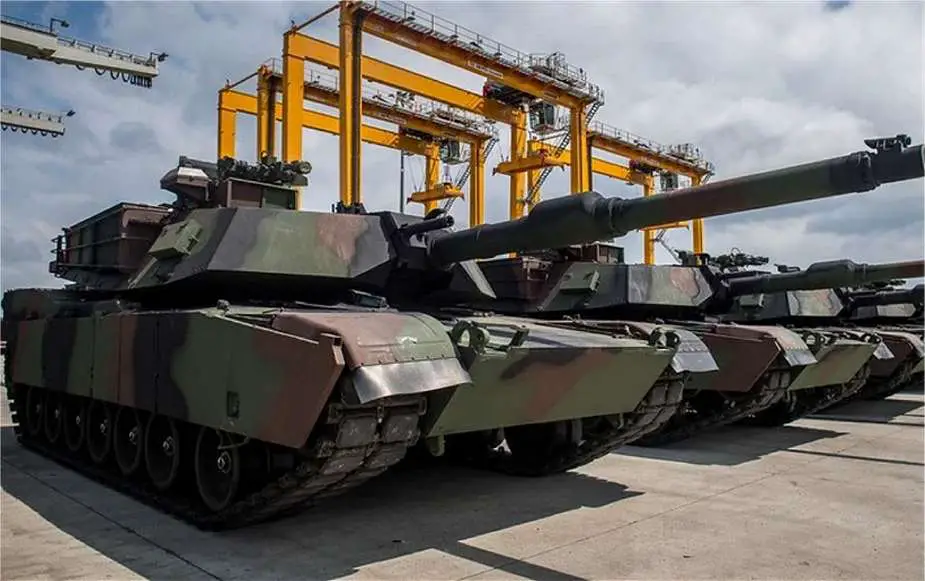Breaking news
Poland Boosts Defense Acquisition to Become Third Strongest NATO Tank Force Amid Russian Threat.
On January 8, 20223, Poland took delivery of a new batch of 29 American M1A1 Abrams that will be delivered to the Polish Army. This is the third tranche of M1A1s to be received by Poland, following deliveries of 14 tanks in June 2023 and 26 in November 2023. With its recent enhancements in defense capabilities, Poland has ascended to become the third most powerful NATO country in terms of military strength, particularly in countering the Russian threat.
Follow Army Recognition on Google News at this link

On January 8, 2023, 29 American M1A1 Abrams MBTs Main Battle Tanks were delivered to Poland. (Picture source Poland MoD)
In January 2023, the Polish and U.S. Governments agreed on the transfer of 116 M1A1 Abrams MBTs (Main Battle Tanks) to Poland for USD 1.4 Bn (EUR 1.3 Bn). The latest tank delivery of this order will be completed by the end of 2024.
The scope of delivery also includes 12 M88A2 Hercules armored recovery vehicles, eight M1 Abrams-based M1074 Joint Assault Bridges, six M577 command post vehicles, and 26 next-generation Shop Equipment Contact Maintenance (SECM) shelters mounted on Humvee chassis as well as a training and logistics package.
Due to the latest order of Main Battle Tanks by the Polish Government, Poland will be the country in Europe that will have the largest quantity of tanks to face the new threat from Russia. Currently, the Polish army is equipped with 126 Leopard 2A4, 105 Leopard 2A5, 16 Leopard 2PL, and around 200 PT-91 Twardy.
In 2022, Poland made significant advancements in its military capabilities through two major tank acquisition contracts. The first was with the United States for the purchase of M1A2 Abrams SEPv3 tanks. The deal, valued at approximately $4.75 billion, included 250 of these advanced tanks. The contract not only involved the tanks themselves but also encompassed a comprehensive package including technical support, logistics, training, and ammunition. This acquisition was a part of Poland's effort to modernize its military forces and replace outdated Soviet-era tanks like the T-72 and PT-91 with more advanced platforms.
The second major contract was with South Korea, formalizing a $5.7 billion deal for the purchase of K2 Black Panther tanks and K9 Thunder self-propelled howitzers. This contract involved an initial tranche of 180 K2 tanks and a total of 1,000 K2 tanks could be acquired by Poland. The K2 tanks are known for their advanced fire control, active protection, and communication systems. This deal was part of a broader modernization initiative by Poland, which also included the procurement of FA-50 light combat aircraft. The K2 tanks and the Abrams were intended to replace Poland's older T-72 and PT-91 Twardy tank fleet, significantly enhancing the country's armored capabilities.
These acquisitions reflect Poland's strategic intent to strengthen its military in response to the changing geopolitical landscape, particularly in light of the ongoing tensions and conflicts in Eastern Europe. The choice of tanks from both the United States and South Korea illustrates Poland's approach to diversifying its military technology sources and enhancing its defense capabilities with some of the most advanced armored vehicles available.
As of 2024, European countries exhibit a wide range of tank fleets, reflective of their respective military capabilities and strategic priorities. Russia stands out with the largest tank fleet in Europe, boasting approximately 12,566 tanks. This significant number underscores Russia's substantial investment in armored warfare and its historical emphasis on large-scale land forces. Turkey, as a major NATO member, holds the second-highest number of tanks in the alliance with about 2,229 tanks. This indicates Turkey's substantial commitment to maintaining a strong, conventional land force capability. Other countries like Greece and Poland also maintain notable tank fleets, with Greece having around 1,365 tanks and Poland about 569 tanks. These figures suggest a continued reliance on armored vehicles for national defense in various European contexts.
Other European countries, though possessing smaller fleets, still maintain a presence in armored warfare. Germany, the United Kingdom, and France, traditionally key players in European defense, have tank counts of approximately 266, 227, and 222 respectively. Italy and Spain also contribute to Europe's overall tank strength with 197 and 327 tanks respectively. These numbers, while smaller compared to Russia or Turkey, reflect a strategic balance between different types of military capabilities and the evolving nature of modern warfare, where the role of tanks is balanced against other defense needs. It's important to note that the quantity of tanks does not directly equate to military effectiveness, as factors like technology, maintenance, and operability play crucial roles. The variety in tank numbers across Europe illustrates diverse defense strategies and priorities among different nations.
Upon the completion of its ongoing tank acquisitions, Poland is set to significantly enhance its military profile within NATO. With the anticipated total reaching approximately 2,000 tanks, Poland will emerge as the third most formidable force in terms of main battle tank (MBT) firepower within the NATO alliance. This considerable expansion of Poland's tank fleet not only enhances its national defense but also contributes significantly to the collective strength and deterrence posture of the NATO alliance in the face of evolving security challenges in the region.
Defense News January 2024



















